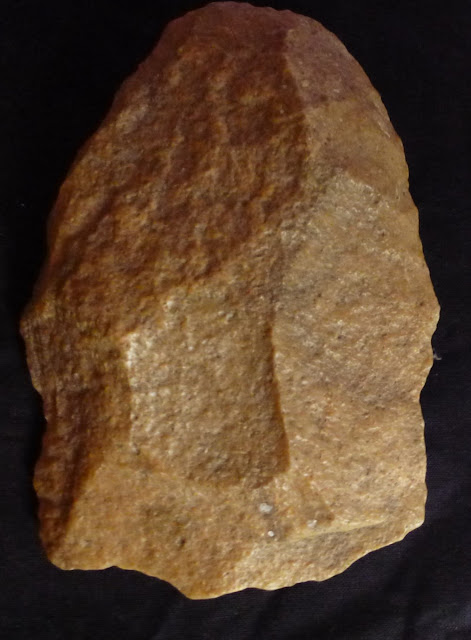Provenance: Found in a 1969 expedition and recently purchased from a private collection in the United Kingdom.
Age: 200,000 years old
Size: approx: 16cm
This is by far the oldest hand made object in my collection of pre-historic tools made by a Hominid in Africa before the rise of modern hominids - us.
This handaxe is a typical African Acheulian shape, bifacial worked into a sharp cleaver point on the distal end and a worked rounded base. Continuous retouches evidenced on the edges meaning that the tool was carried for some time before discarded. The handaxe shows a perfect typical brownish patina and wind polished surface. In mint, near perfect condition with no modern or old damage and intact.
This handaxe is a typical African Acheulian shape, bifacial worked into a sharp cleaver point on the distal end and a worked rounded base. Continuous retouches evidenced on the edges meaning that the tool was carried for some time before discarded. The handaxe shows a perfect typical brownish patina and wind polished surface. In mint, near perfect condition with no modern or old damage and intact.
The artefact was discovered in 1967 at Erg Belfelfoul, Algeria. Handaxes with exact site location are extremely rare.
Acheulean (pron.: /əˈʃuːliən/; also Acheulian) (from French acheuléen, a term based on the name Saint-Acheul, a suburb of Amiens, the capital of the Somme department in Picardy, where hand-axes of this period were found in 1859), is the name given to an archaeological industry of stone tool manufacture associated with early humans during the Lower Palaeolithic era across Africa and much of West Asia, South Asia, and Europe. Acheulean tools are typically found with Homo erectus remains. It is thought that they first developed out of the more primitive Oldowan technology as long ago as 1.76 million years ago, by Homo habilis.
It was the dominant technology for the vast majority of human history starting more than one million years ago. Their distinctive oval and pear-shaped handaxes have been found over a wide area and some examples attained a very high level of sophistication. Although it developed in Africa, the industry is named after the type site of Saint-Acheul, now a suburb of Amiens in northern France (not to be confused with the rural commune of Saint Acheul), where some of the first examples were identified in the 19th century.


No comments:
Post a Comment